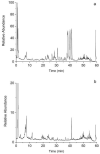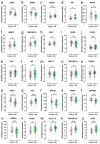Identification of Uncaria rhynchophylla in the Potential Treatment of Alzheimer's Disease by Integrating Virtual Screening and In Vitro Validation
- PMID: 37895137
- PMCID: PMC10607254
- DOI: 10.3390/ijms242015457
Identification of Uncaria rhynchophylla in the Potential Treatment of Alzheimer's Disease by Integrating Virtual Screening and In Vitro Validation
Abstract
Uncaria rhynchophylla (Gouteng in Chinese, GT) is the main medicine in many traditional recipes in China. It is commonly used to alleviate central nervous system (CNS) disorders, although its mechanism in Alzheimer's disease is still unknown. This study was designed to predict and validate the underlying mechanism in AD treatment, thus illustrating the biological mechanisms of GT in treating AD. In this study, a PPI network was constructed, KEGG analysis and GO analysis were performed, and an "active ingredient-target-pathway" network for the treatment of Alzheimer's disease was constructed. The active ingredients of GT were screened out, and the key targets were performed by molecular docking. UHPLC-Q-Exactive Orbitrap MS was used to screen the main active ingredients and was compared with the network pharmacology results, which verified that GT did contain the above ingredients. A total of targets were found to be significantly bound up with tau, Aβ, or Aβ and tau through the network pharmacology study. Three SH-SY5Y cell models induced by okadaic acid (OA), Na2S2O4, and H2O2 were established for in vitro validation. We first found that GT can reverse the increase in the hyperphosphorylation of tau induced by OA to some extent, protecting against ROS damage. Moreover, the results also indicated that GT has significant neuroprotective effects. This study provides a basis for studying the potential mechanisms of GT in the treatment of AD.
Keywords: Alzheimer’s disease; Uncaria rhynchophylla; network pharmacology; p-tau.
Conflict of interest statement
We confirm that this work is original and has not been published elsewhere, nor is it currently under consideration for publication elsewhere. We have no conflict of interest to disclose.
Figures









References
MeSH terms
Substances
Supplementary concepts
Grants and funding
LinkOut - more resources
Full Text Sources
Medical
Miscellaneous

